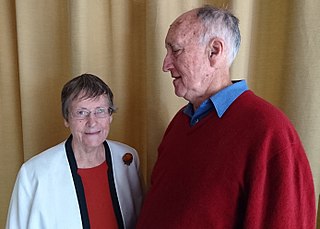Related Research Articles

John Coleridge Patteson was an English Anglican bishop, missionary to the South Sea Islands, and an accomplished linguist, learning 23 of the islands' more than 1,000 languages.

Religion in Papua New Guinea is dominated by various branches of Christianity, with traditional animism and ancestor worship often occurring less openly as another layer underneath or more openly side by side with Christianity. The courts, government, and general society uphold a constitutional right to freedom of speech, thought, and beliefs. A secular state, there is no state religion in the country, although the government openly partners with several Christian groups to provide services, and churches participate in local government bodies.
Alfred Harold Wood OBE was a 20th-century Australian Christian minister, educator, writer, hymnologist and advocate of church union.
The Tolai are the indigenous people of the Gazelle Peninsula and the Duke of York Islands of East New Britain in the New Guinea Islands region of Papua New Guinea. They are ethnically close kin to the peoples of adjacent New Ireland and tribes like the Tanga people and are thought to have migrated to the Gazelle Peninsula in relatively recent times, displacing the Baining people who were driven westwards.

George Brown was an English Methodist missionary and ethnographer.
The Catholic Church in Papua New Guinea is part of the worldwide Catholic Church, under the spiritual leadership of the Pope in Rome. Papua New Guinea has approximately two million Catholic adherents, approximately 27% of the country's total population.
The Congregational Christian Church of Tuvalu, commonly the Church of Tuvalu, is a Christian Church which is the state church of Tuvalu, although this status merely entitles it to "the privilege of performing special services on major national events". Its adherents comprise about 97% of the ~11,000 inhabitants of the archipelago, and theologically, it is part of the Calvinist tradition.
Joseph Waterhouse was an English-born Australian Methodist minister and missionary in Fiji. He is credited with having converted Seru Epenisa Cakobau, the chief of Bau and King of Fiji, to Christianity.
Taukei ni Waluvu is a Fijian phrase for "Native of the Flood." It is the traditional chiefly title of the warrior hill clan Siko-Natabutale of Nairukuruku village. The history of the clan from the mid- nineteenth century, represent the social structures of the chiefly system, religion and western culture that supported colonialism in Fiji. Tradition, Christianity and British indirect rule were combined to legitimize what was accepted as the right way to govern. Condemned by some modern day critics as exploitative, the Fijian chiefly system was the medium of native social interdependence and a traditional contract shared by the indigenous clans of pre-colonial Fiji, that was utilized for colonial rule. Since Independence the chiefly system has had to adapt to the demands of modernity. Anthropologist Arthur Capell in his study of early tribal migration within Fiji made the point that, "the history of Fiji is the history of chiefly families." The phrase in fact emphasized the hierarchical nature of Fijian traditional society where chiefly power was held sacred. The relationship between Chiefs and Westerners in especially Missionaries thus became a focal point for gathering insight into Fijian culture and tradition in the nineteenth century. James Turner a latter anthropologist found, "The chiefly families of Nairukuruku were the first in the eastern highlands of Viti Levu to declare their allegiance to the central government and as a result of this support their influence expanded throughout the area".
Sione Lātūkefu was a Tongan academic and historian, and the author of several significant works on Tongan history.
James and Mary Wallis were Wesleyan missionaries and the first European Settlers in Raglan, New Zealand.
Alan Richard Tippett was a Methodist missionary, missiologist, and anthropologist.

Margaret Reeson is an Australian historian, biographer, and author, and prominent leader of the Uniting Church in Australia.
Sailasa Naucukidi was a Fijian Methodist-Wesleyan missionary who volunteered to take the Gospel of Jesus Christ to New Britain, Papua New Guinea in 1876. In 1878, he was martyred and his remains cannibalized. His remains along with other Fijian martyrs lay buried atop the Vunela Fijian martyrs cemetery Kabakada, East New Britain.
Ratu Ilaijia Varani was a chief of Viwa, Bau Island, Tailevu in Fiji in the mid-to-late 19th century.
Davuilevu, the name of the site of three Methodist Church of Fiji institutions: Davuilevu Theological College, the Bible School for Catechist training, and Lelean Memorial School. It can be translated as "the large conch shell."
Josua Mateinaniu was a preacher and catechist (teacher) in the Methodist Church of Fiji and Rotuma. A wanderer and a sailor at first, he drifted in his travels to Tonga, where he became a Christian.
Charles Oswald Lelean (O.B.E) was born in 1867 in Tasmania, Australia and died at the age of 72 on 14 September 1942. He had spent a considerable part of his life being a missionary in Fiji. Rev Lelean served in Fiji for 36 years.
Lelean Memorial School is one of the largest co-ed schools in Fiji. It was established in 1943 and is run by the Methodist Church of Fiji and Rotuma. It is co-located at the Davuilevu Methodist Compound with the Davuilevu Theological College and the Young People's Department, which runs training for Methodist catechists.

John Hunt was an English missionary known for converting Fijian cannibals to Methodism.
References
- ↑ "CHURCH, MEN AND EVENTS Roman Catholic Schools". Melbourne Herald. 7 January 1926. p. 14. Retrieved 28 April 2023– via National Library of Australia.
- 1 2 "Martyrs of the islands". Fiji Times. 16 March 2014. Retrieved 28 April 2023.
- ↑ "A MISSIONARY HERO". The Methodist. 10 February 1923. p. 2. Retrieved 28 April 2023– via National Library of Australia.
- THORNLEY, Andrew, 1982, ‘Custom, Change and Conflict: Fiji Wesleyan missionaries, 1835–1945’, in Melanesia: beyond diversity, vol.1, eds R.J. May and Hank Nelson, Research School of Pacific Studies, Australian National University, Canberra.
- TIPPETT, A.R., 1954, The Christian (Fiji 1835–1867), Auckland Institute and Museum, Auckland.